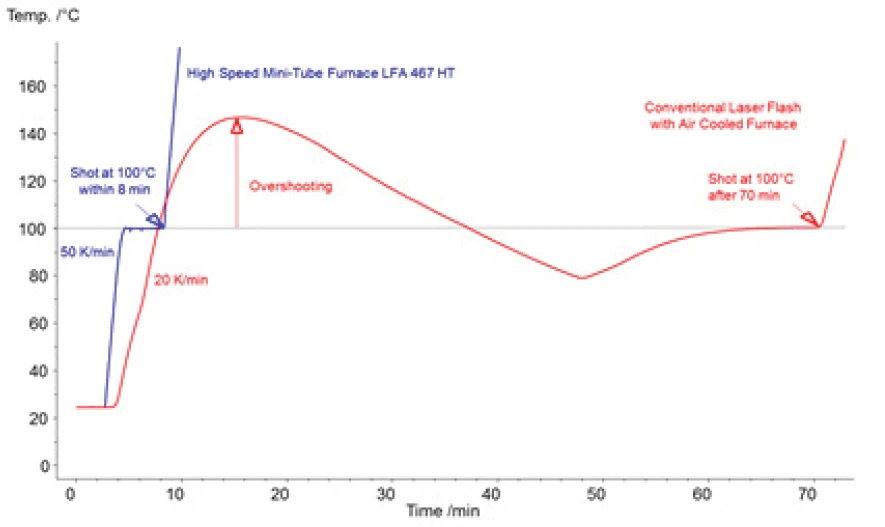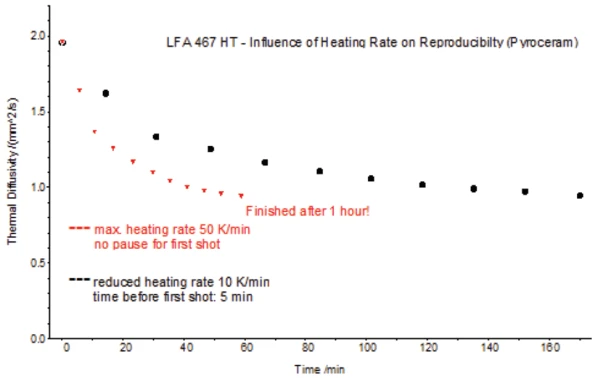Introduction
The use of laser/light flash systems (LFA) for the determination of Thermal DiffusivityThermal diffusivity (a with the unit mm2/s) is a material-specific property for characterizing unsteady heat conduction. This value describes how quickly a material reacts to a change in temperature.thermal diffusivity is well-established – specifically in the fields of thermophysical properties testing. The development of new materials or electronic components is also accompanied by the enhancement of conventional LFA systems. The LFA 467 HT HyperFlash was designed to address the demands arising from trends in both science and industrial applications. A variety of new features – such as flash applications to beyond 1250°C, ZoomOptics , an ultrafast sampling rate (2 MHz), a short pulse width (< 20 μs), etc. – accommodate the requirements for state-of-the-art applications such as thin and highly conductive materials (thin films).
Furthermore, conventional LFA systems find their way into all kinds of laboratories ranging from R&D to quality assurance. Extensive use of this technique requires additional characteristics to address practicality issues. Besides high precision and a small footprint, a high sample throughput is often needed. This can be achieved by the use of an automatic sample changer or a fast furnace or a combination of both.
The LFA 467 HyperFlash® offers such a combination in the form of four individual fast-responding mini-tube furnaces for a total of four specimens (figure 2). These are arranged in a square at the same level and are characterized by superior stabilization behavior. Each mini-tube furnace has its own thermocouple; this design offers a homogeneous temperature distribution across all samples, which is beneficial for determination of the specific heat (Specific Heat Capacity (cp)Heat capacity is a material-specific physical quantity, determined by the amount of heat supplied to specimen, divided by the resulting temperature increase. The specific heat capacity is related to a unit mass of the specimen.cp). In addition, the surrounding area is water-cooled and the entire furnace system has a low thermal mass. The combination of these specific features not only guarantees high sample throughput, but is also a prerequisite for short measurement times.


Measurement Conditions and Results
- Sample: Pyroceram (Ø 12.7 mm; 2.5 mm thick)
- T range: 25°C → 1000°C → 30°C in steps of K
- Heating rate: 50 K/min (maximum heating rate)
- Atmosphere: Argon
- Shots: 1 shot per temperature step
- Stability criteria: 0.3 K/20 s
- ΔT: 3 K
The following example demonstrates the advantages of the LFA 467 HT HyperFlash over LFA systems with a conventional air-cooled furnace.
The comparison in figure 3 clearly shows that the stabilization time of the high-speed mini-tube furnace with water cooling is nearly three times faster. This goes hand-in-hand with a higher sample throughput. Within six hours, the LFA 467 HT HyperFlash® is able to measure 12 specimens (four samples at the same time) at temperatures of up to 1000°C. Conventional LFA systems with air cooling – even those with larger ASC capabilities – exhibit difficulties in achieving such high throughput due to poor stabilization behavior.

Figure 4 depicts the very fast stabilization time of the LFA 467 HT HyperFlash compared to a conventional system. By applying the maximum heating rate of 50 K/min up to the first temperature step at 100°C, the first shot can be carried out within 8 min. In contrast with the conventional furnace with air cooling, the low thermal mass of the 4-mini-tube furnace system exhibits no overheating and an extremely short stabilization time. A comparison of the Thermal DiffusivityThermal diffusivity (a with the unit mm2/s) is a material-specific property for characterizing unsteady heat conduction. This value describes how quickly a material reacts to a change in temperature.thermal diffusivity results obtained via measurements on Pyroceram at different heating rates demonstrates the high reproducibility which can be achieved – even when using the maximum heating rate of 50 K/min (figure 5).


The low stabilization time of the high-speed 4-mini-tube furnace system and the resulting ability to apply the LFA shots without intermission allows for very fast testing times. Figure 6 plots the Thermal DiffusivityThermal diffusivity (a with the unit mm2/s) is a material-specific property for characterizing unsteady heat conduction. This value describes how quickly a material reacts to a change in temperature.thermal diffusivity results against time. At a heating rate of 50 K/min, the measurement was completed after only 60 min – whereas testing time increased to 170 min at a heating rate of 10 K/min.

Conclusion
The mini-tube furnaces of the LFA 467 HT HyperFlash feature excellent stabilization time, which allows for measurements at an accelerated tempo. This makes the 4-mini-tube furnaces to a high-speed system which can be operated at the highest of heating rates without experiencing a loss in reproducibility and accuracy. The high testing speed even allows for faster throughput than is enabled by systems with automatic sample changers for more than 4 samples.